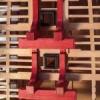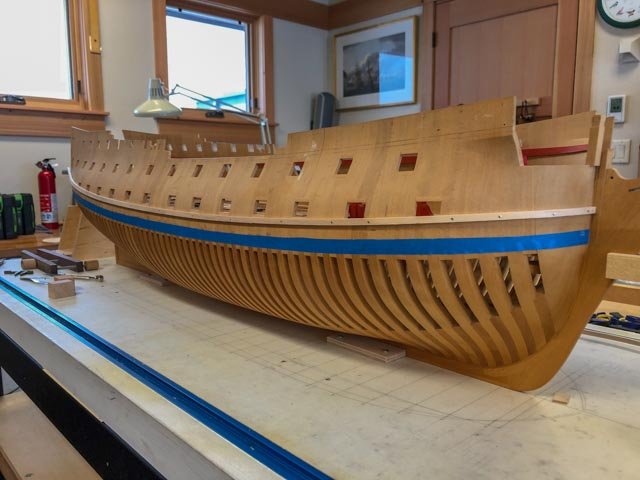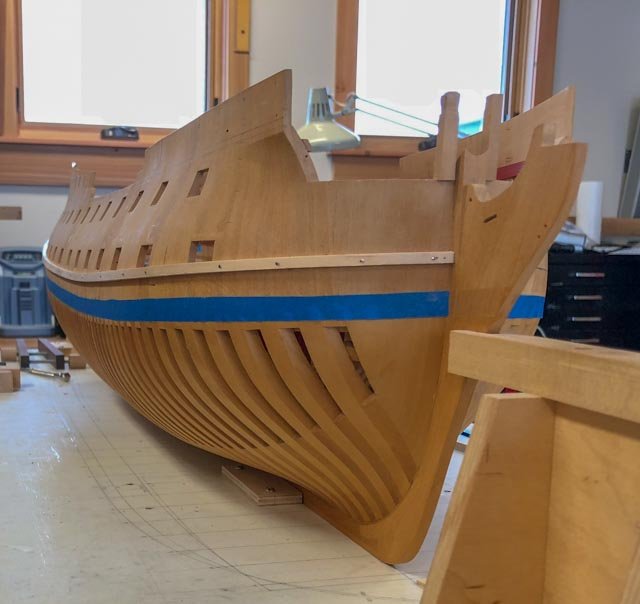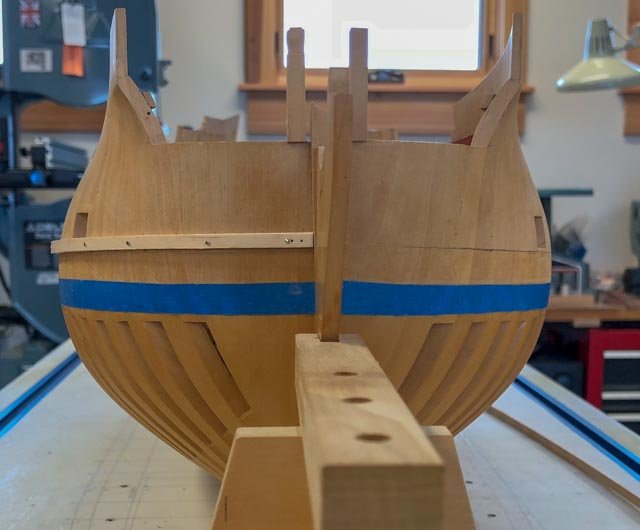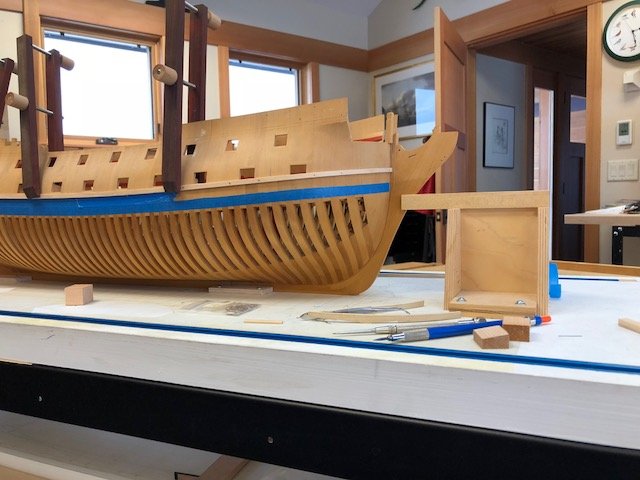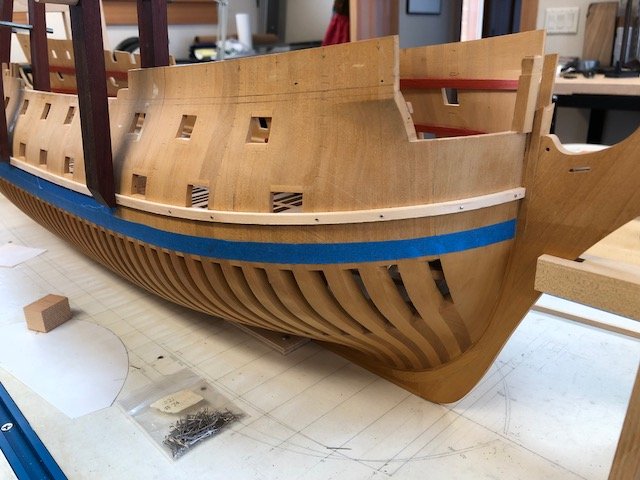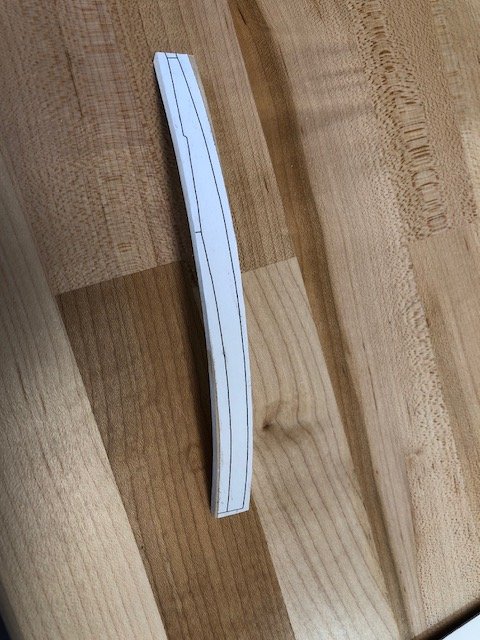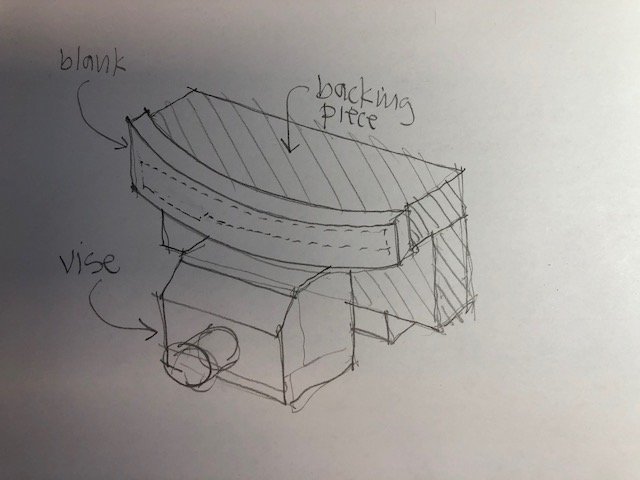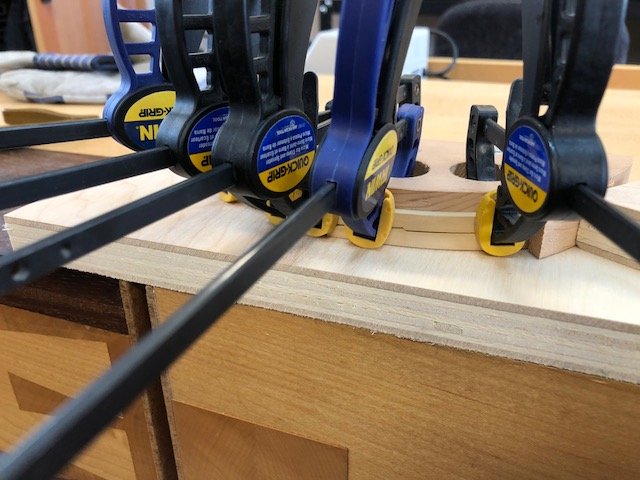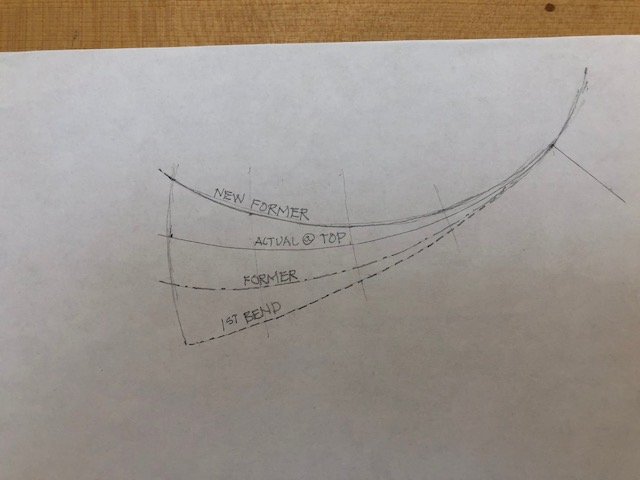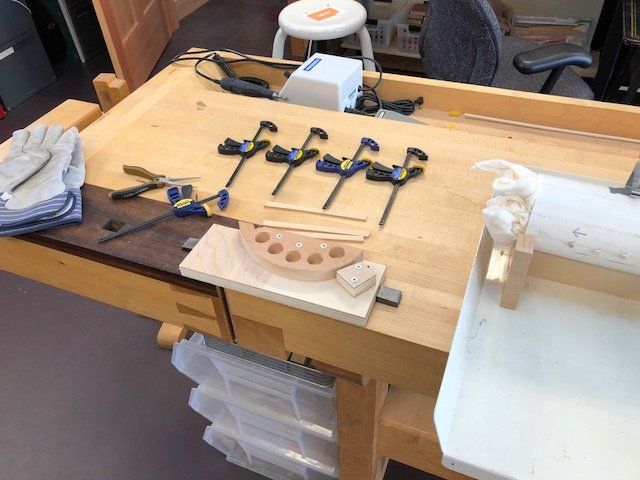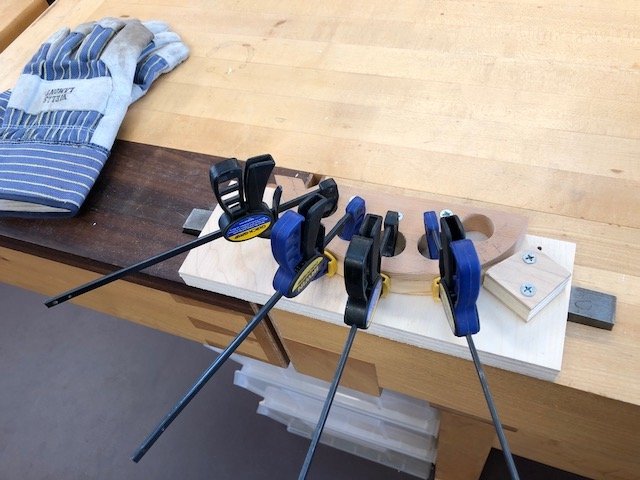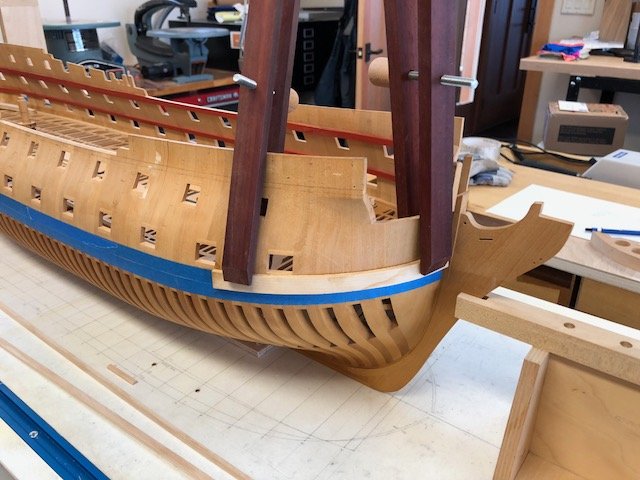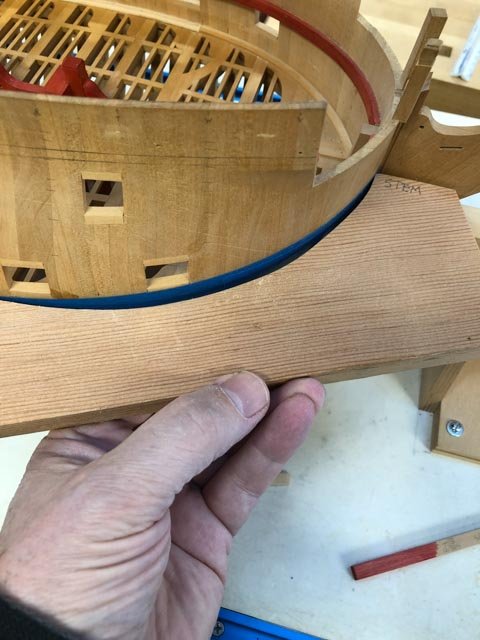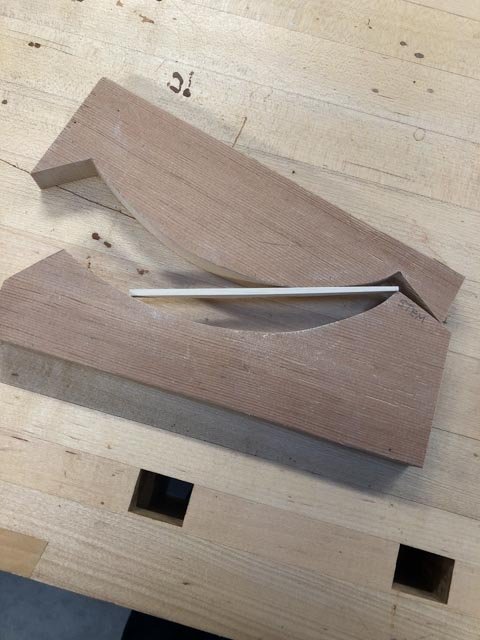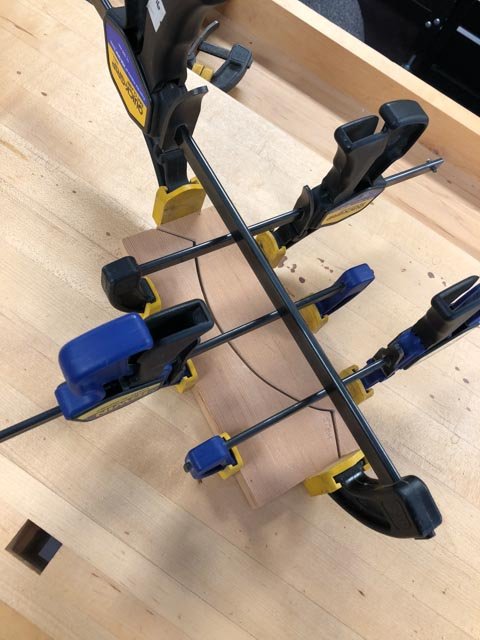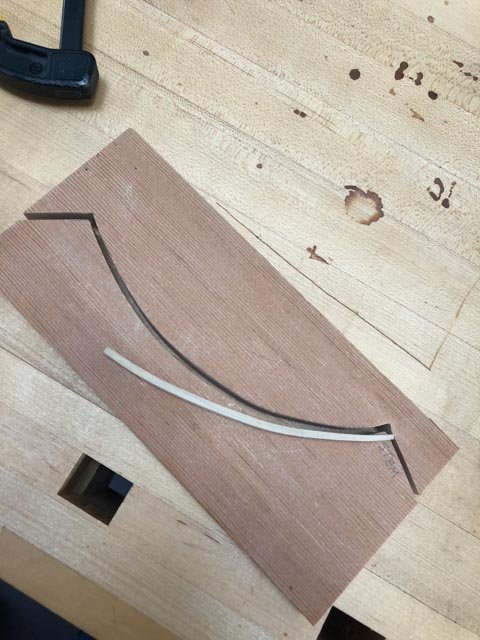-
Posts
1,649 -
Joined
-
Last visited
Content Type
Profiles
Forums
Gallery
Events
Everything posted by SJSoane
-
Thanks, druxey, you were right, the point at the stem had crept up. Here is the batten with the corrected curve. Gary's recommendation of a batten against which to set the wales is really proving to be a great idea. I was able to use it to accurately spile the topmost, foremost plank, and this showed me that there was greater curve on the upper surface than I had previously drawn (my CAD drawing had assumed, I realize in hindsight, that the surface was completely vertical, and this is not the case). The last photo shows how much the upper plank curves. It just goes to show that there is no shortcut to reliable techniques. Set a batten, and spile the planks, set a batten and spile the planks, repeat until this lesson is never forgotten! Mark
-
Hi Michael, I don't know, if the patrons could tip it again, you could stay working on this for a long time to come!🙂 Mark
- 749 replies
-
- albertic
- ocean liner
-
(and 2 more)
Tagged with:
-
I forget to ask in the last post; should an imaginary line connecting the two wales across the stem make a smooth curve? Or do they come to a slight acute angle in relationship to each other? Since the sheer drawing has the wale as a smooth curve up right to when it hits the rabbet, I have been assuming that this would translate into a slight angle to the stem when seen from face on. Mark
-
Thank you, aviaamator, the opinions of all of you really help keep me focused. Following the good advice of Gary on his Alfred build, I am installing a temporary batten at the top of the wale, against which I can fit the upper strakes for a smooth curve. Not quite sure yet if the pre-cut and then bent strake is going to fit tightly here. It needs some "encouragement" to lie flat against the compound curving surface, and I can't see yet if this will cause unreasonable stress. I am learning much at this critical place in the build; critical because it is so obvious if the wale lies correctly or not, and at the head where the viewer's attention will naturally be drawn when the ship is completed.
-
I pulled the pre-cut pieces off the formers this morning, and they bent very nicely to the hull. After pondering the not insignificant program of shaping a curved blank, I think I will have more success with the original plan of bending pre-cut pieces. This allows me to shape tight fitting joinery while pieces are still flat, then bend. There was a little more spring-back on the these pieces that I had previously boiled, compared to the blank I bent the other day that had not been steamed or boiled before. So the boiling did seem to affect the wood before the steaming. Only steaming from now on.. Mark
-
Thanks, Michael. I always appreciate your keen eye and ideas for tooling. Now I have successfully bent a piece, I need to think how I am going to shape it. I am thinking about attaching it to a backing piece that would allow me to clamp it in a vise, as shown in the drawing. Unless someone has a simpler idea. Just for fun, I steamed the original pre-cut pieces that I previously boiled and could not get to the right curvature. They appear to have bent to the former after steaming, as seen in the last photo, and we will see how much spring-back I get tomorrow morning. This is an impromptu experiment in the advantages and disadvantages of cutting and then bending, or vise versa... Mark
-
Thanks, druxey and Mark, I found a little guidance in the book, The Complete Manual of Wood Bending, by Lon Schleining. It recommended forming a curve around a male form only, so the clamps can progressively and smoothly pull the wood up to the curve. My earlier former tried to capture between two halves, and it did not work nearly as well. Mark, the holes in the PVC pipe are for a row of ¼" diameter dowels 1" O.C., which hold the steaming wood out of the condensed water in the bottom of the tube. The entire tube slants to a drain hole at the end opposite the opening, for getting rid of this water. This all came with the instructions I got with the steamer unit, which I found at Woodcraft a few years ago. There are also a number of instructions online, which would be more reliable than mine. I used a rag stuffed in the opening, fearful of creating a bomb with a tight fitting on both ends. The thermometer only got up to 115 degrees, while I was expecting more; but it seems to have worked. I used the formula of 1 hour per inch of wood, multiplied by 2 for kiln dried wood. Since my wale planks are ⅛", this was ⅛ hour times 2 or 15 minutes. It took about 15 minutes from cold to 115 degrees (I put the wood in the cold tube, before heating up), and then another 15 minutes or 30 minutes altogether from beginning to end. I let it dry overnight in the forms, and hit it with a hair dryer the next day just in case. Slow, but I only have to form curved planks from the wales up to the point where the hull flairs out for the catsheads. I am retired, plenty of time! ;-) I might make a few more formers based on the first, using a piloted trimming bit in the router table. then I could steam and clamp a number in the same session. Best wishes, Mark
-
Santa did not bring a soldering iron or heat gun for me this year, so I turned again to the steam box parts that I had purchased a few years ago. I built a new box out of PVC pipe, scaled down to the sizes of wood I need to bend. I tried one former that was not sharp enough bend to allow for the springback, and then modified the bend more sharply to compensate (see sketch below). The final bend came out just right. I am in business! Mark
-
Nice, Gary, looking very good. I don't see your cannon; are those still going to be fitted on both sides of the gundeck? Mark
-
Michael, The more I see your clamping device in action, the more I really appreciate it. The time taken to design and construct a good jig or tool repays itself for the rest of one's life! Mark
- 749 replies
-
- albertic
- ocean liner
-
(and 2 more)
Tagged with:
-
Ed, those close-up photos make it look like the real thing. Imagine climbing out there in heavy weather... Mark
- 3,618 replies
-
- young america
- clipper
-
(and 1 more)
Tagged with:
-
Hi druxey, I got it over 20 years ago from Woodcraft, and it was labeled only as S.A. Boxwood, which I assume is South American Boxwood. Nice to work, very crisp, but is very stiff stuff. Gaetan, I have not had success finding the heating element like Gary showed (it might have been lost or misplaced in my move). Do you have a source for the one you showed here? Mark
-
Michael, Very nice work on the lines. I can see the dilemma; leaving the cruder repairs just doesn't seem shipright! Mark
- 749 replies
-
- albertic
- ocean liner
-
(and 2 more)
Tagged with:
-
Hmm, my nemesis, bending 9/64" thick wood... I cut the former with a greater curve to accommodate spring-back, boiled the pieces for 1 ½ hours, and then clamped them overnight. But as the first photo shows, the spring-back was much more significant than I had planned. So there are three variables here: 1) the curvature of the former; 2) the time boiling; and 3) the time clamped in the former. Before I start experimenting with different curvatures of the former, does my boiling time and bending time seem about right? The good news is that the two strakes I bent at the same time came out with the same curvature, even though one was much longer than the other, and the joints fit well. Best wishes, Mark
-
Thanks, Gary, I will try this. I already cut out the parts based on an expanded planking plan, so we will see how well the jig saw puzzle goes together when it goes on the hull. Some are probably going to be recut. Did you find it helpful to have the batten at the top of the wale? Gaetan, your comment is a good reminder that so much of craftsmanship involves responding to the nature of the materials, and adapting and refining as the form begins to develop. I understand this is how the shipwrights worked, and why they needed relatively few drawings compared to the number of drawings required in our more automated construction processes today. Maybe we enjoy ship model construction in part because it lets us participate in a process when the craftsman's skills and judgement were more important. And druxey, you are right about no dumb questions, but in hindsight it was a question I asked dumbly; the answer does depend entirely on the type of glue, which I neglected to mention. Since I am using yellow carpenter's glue, the answer to my own question is that it will come apart. I am going into the shop to try bending these individually against a former. Thanks everyone! Mark
-
John, Greg, thanks for the comments. It is great to be going again. I planned to bend wood today, but it took most of the day to refine the joints and plank widths and thicknesses at the bow. Dumb question; if I glued together the two planks shown, would they separate after boiling them for bending? I can see some value in bending these together, to keep the joint tight. I may also try making a caul shaped to the bow, and use this to ensure uniform bending if I have to do these separately. Mark
-
Thanks, Mark, I am going to get up early tomorrow, bend some wood, and then see where I stand. The first planks at the bend are so long that once I get past those, the rest fit fairly snuggly against the hull. So I will only have to remake about 4 per side if they are too short. Druxey, if you are reading, can you remind me how much the first planks are thinned at the fore end to fit the rabbet at the stem? The wales are 8 ½" at their fullest thickness. Every little thinning will help me here! Best wishes, Mark
-
Hi Gaetan, I did my best to construct a true projection of the wales in CAD, and I taped a print of this drawing on the hull itself to confirm its shape and length. So far so good. But I do have concerns about what happens to these pre-cut joints when I bend the strakes at the bow. I may have to throw away the ones I pre-cut and replace them with pieces hand-fitted to the space after being bent. And as Greg pointed out, I also need to bevel the edges to fit the curve of the hull vertically. I have to attend a social event today, but I hope to try a first bend of the foremost strakes tomorrow, and see what happens. Best wishes, Mark
-
Gary, Great to see your build again! I will follow your progress with enthusiasm. And that new bench looks terrific. Hard to pass by that without it calling you to sit down and work on something... Mark
About us
Modelshipworld - Advancing Ship Modeling through Research
SSL Secured
Your security is important for us so this Website is SSL-Secured
NRG Mailing Address
Nautical Research Guild
237 South Lincoln Street
Westmont IL, 60559-1917
Model Ship World ® and the MSW logo are Registered Trademarks, and belong to the Nautical Research Guild (United States Patent and Trademark Office: No. 6,929,264 & No. 6,929,274, registered Dec. 20, 2022)
Helpful Links
About the NRG
If you enjoy building ship models that are historically accurate as well as beautiful, then The Nautical Research Guild (NRG) is just right for you.
The Guild is a non-profit educational organization whose mission is to “Advance Ship Modeling Through Research”. We provide support to our members in their efforts to raise the quality of their model ships.
The Nautical Research Guild has published our world-renowned quarterly magazine, The Nautical Research Journal, since 1955. The pages of the Journal are full of articles by accomplished ship modelers who show you how they create those exquisite details on their models, and by maritime historians who show you the correct details to build. The Journal is available in both print and digital editions. Go to the NRG web site (www.thenrg.org) to download a complimentary digital copy of the Journal. The NRG also publishes plan sets, books and compilations of back issues of the Journal and the former Ships in Scale and Model Ship Builder magazines.


